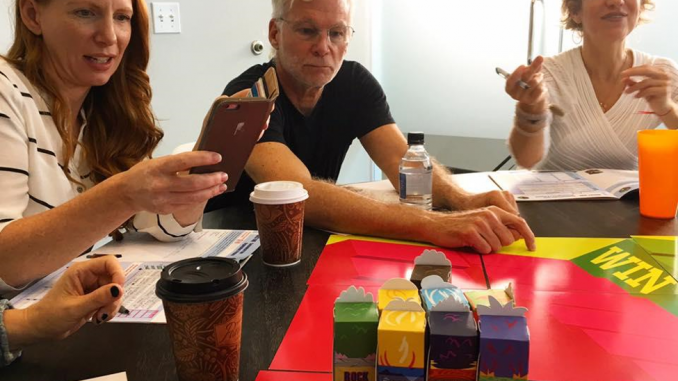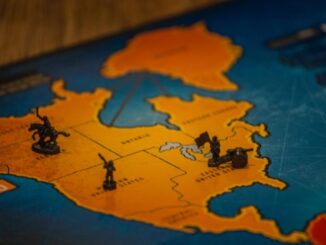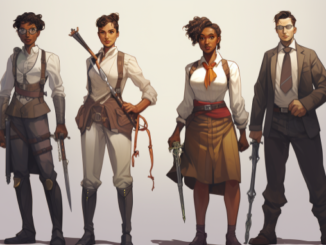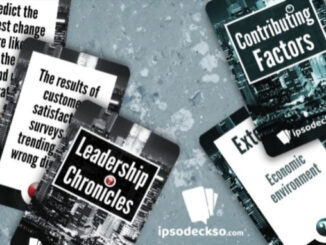
The best games call on us to use our talent and imagination to play, learn and excel. So do the best workplaces.
I didn’t start out making games. But I quickly recognized that play was the active ingredient in fostering workplace creativity, learning and change.
The first time I used play to solve a business problem, The Denver Post wrote a story about it and my boss tried to fire me for upstaging her. That’s how I knew I had something of value. The next time I used play to solve a business problem, I created a P&L game for my retail managers. We broke sales and profitability records, and my boss took credit for making the game. Yup, I definitely had something of value.
A friend suggested I ‘take my little treasures’ and go make games and playful experiences to help other people solve their business problems. Be my own boss. Soon, I was watching hundreds of drugstore managers so deeply engaged in playing their performance improvement game (The Bottom Line Game), they didn’t want to leave for lunch. Later, the CEO pointed me out in the back of the room and said, “I have never seen people rush back from lunch to play a learning game. Bravo!”
This is when I started making games.
For decades now, I’ve worked alongside creative colleagues and clients to design games and playful experiences that help people work and learn together in new ways to solve all kinds of business problems in all kinds of industries. Serious problems that can keep people and businesses from growing, like innovating drug development, leading organizational change, business acumen, advancing selling skills, expanding product lines, executing strategy, learning to learn, changing culture, retaining talent, increasing revenues, creative product development, mastering skills. To name a few.
My games (board games) and experiences (live, interactive) are largely custom-made for each client. I never make the same game or solve the same problem twice so I can keep learning, too. What is the same about every game and experience are these signature principles:
- Co-created with clients
- Self-facilitated by participants
- Collaborative and competitive
- Gameplay requires new behaviors
- Game named for higher purpose
- Engaging visual design
Recently, I wondered if my thirty years of game making – so far – held any lessons worth sharing with a wider audience of makers and users. I asked my nephew Ryan Baechler for his insight and he responded like he’d been thinking about it all his life. “Sue, when people play your games, the play is the work. To play, score and win is to learn, do, and change. That’s what makes your games so valuable and unique.”
The play is the work. Everyone should have a nephew like Ryan, who also happens to be a creative publishing and product development executive. I took this as a ‘yes’, so here are a few lessons in hopes that more people will make and use games and playful experiences to foster creativity, learning and change.
Lesson 1. It’s play that helps us do serious things better
I wish I’d said this, but it was Jake Orlowitz, Wikipedia founder. Here’s his whole thought:
“It’s play that makes people unafraid to fail and confident to try new things. It’s play that helps us do serious things better because we enjoy them and feel a sense of joy in our achievements.”
All the games and experiences I’ve made help people do serious things better. It’s where the conversation starts with business leaders. What do people need to learn and do to stay competitive? What do people have to know, feel and do to change behavior? What are they doing now? What’s in the way of change happening? Who needs to work together to make these changes/improvements? What does a successful outcome look like?
Once I know what the leaders think has to happen for the game experience to be productive, I go to the people whose behavior has to change. The game participants. I ask them the same questions so I know how to acknowledge what they already know and do, and fully engage them in the experience. Then, I design the game for the participants, knowing the leaders will get what they want.
For example, a biotech company was competing for top talent and competitive advantage. Specifically, their drug developers needed to work more creatively and collaboratively so that new drugs could be discovered and delivered to patients faster and better. Nothing is more serious than that. When I questioned leaders and participants, they all embraced the business goals and behavior change. They wanted a game experience that engaged them in the whole system of drug development (not just their function or role) so they could better understand how they could be more creative and influential. They wanted to try out new behaviors in the game, see the impact on patients, collaborate outside their silos and make real progress together to accelerate behavior change. We named the game Ring That Bell after the symbolic ‘bell ringing’ at the FDA when a new drug is approved. The ultimate ‘win’ for all drug developers.

Lesson 2. Games are transforming the way people work and learn
Transformation is change. And, it’s what the best games do best. Behavior change during and beyond game play is what I strive to achieve with every new game and playful experience. Jesse Schell, owner of Schell Games and Carnegie Mellon University professor called out this higher purpose of games in his book The Art of Game Design, saying that “games are on the verge of transforming the way people work and learn in the same ways they already change consumer behavior.” Game designer Sabrina Culyba wrote The Transformational Framework, based on her work at Schell Games to help game developers intentionally focus on the player’s behavior beyond the game, not just inside the game world.
Those of us who make games that are intended to change behavior, know that all games are not the same. Will it be like Monopoly? the hotel executive asked me as we discussed how we would empower guest services people in a new game. We imagine it working like Oregon Trail, the scientists told me as we talked through how people would learn new ways to work together. In my experience, the best games and playful experiences are co-created with client teams who start with what they know and like about consumer games they’ve played, and leap to a whole new level of expectations as they realize the transforming potential of games and play.
In another example of taking leaps to transform how people work and learn together, a client team told me how they needed a new way to teach their 450 consultants how to sell services and grow revenues during their annual 48-hour sales meeting. Their mantra was ‘bigger, farther and faster’. I asked, “What if you brought your clients and consultants together in a live, interactive learning experience to discover more potent ways to accelerate growth? Everyone could learn, do and change together in real time. And, what if the clients paid for the experience?” It was a bold idea, yes, but well within the transforming power of gameplay. We invented the large game-like experience, named it BiFF (Bigger, Farther, Faster).
Not everyone on the client team was convinced up front that a playful, fun, game-like experience could change how consultants sell and increase revenues. In fact, some did not participate much in the planning and execution, just in case it was a failure. As my journalist friend and performance strategist Joe Robinson says with a wink “Grownups have responsibilities — problems — for crying out loud. They can’t have fun while learning.” But, when the CEO’s of six client companies stood up at the end of the event to describe how they’d been ‘BiFFed’ – one even declaring out loud he would re-engage the consultancy – everyone took credit for the success. They even deemed BiFF a ‘powerful competitive advantage’ and turned it into a continuing education program — for crying out loud.
Lesson 3. Why those who play, win.
How do you know the game is going to work?
Not everyone likes playing games.
Games don’t seem serious enough for adult learning.
We don’t play games in our company.
When you say games, do you mean like Jeopardy? Or ice breaker exercises?
I still hear resistance like this when the topic of games for learning and change comes up. And, it can be a good place to start a conversation about why those who play, win. But, it’s more and more likely now that I hear:
We’re excited about using a gaming approach.
We sketched out a game idea and want you to help us make it.
A game would get more creative results than what we’re doing now.
Teach us how to make a game while we’re co-creating the game.
In an article I contributed to a few years ago for People and Strategy Magazine, about how games improve performance and results, my game maker and learning mentor Dr. Michael Carter explained why those who play, win.“In some cases, a game’s critical ingredient is simply the suspension of disbelief: Players enter an environment that prompts them to make choices, solve puzzles and generate original solutions. The value-add to a real situation is the license to fail, the no-fault nature of gameplay — it’s great to win but not really fatal to make a mistake, which, after all, is one of the best ways to learn something so you’ll never forget it.
In other cases, the special sauce is the teamwork, where players learn to gauge each others’ value to the effort and judge whom best to rely on at critical junctures.
In all cases, a game is about play, learning and trying to excel. As such, it draws as deeply as possible from those who engage.”
The play is the work. To play, score and win is to learn, do, and change.
Games aren’t magic. But they are compelling. As game co-creator, friend and creativity expert Dr. Steven Kowalski points out: “No wonder business professionals are leveraging gaming design principles and mechanics in everything from executive development to performance management and goal setting, to even the budgeting process. Gaming technologies rely on the small wins — and often sudden leaps — in achievement and skill.”
As you game makers and players know, it takes a thoughtful design and a genuine enthusiasm for people to create game frameworks that trust players’ emotions, creativity and motivations to work, learn and change together to achieve a goal. In front of each other. In a work setting.
But, when the play is the work, it works.
- Keeping the Player Smart - 11th March 2020
- The Play is the Work - 15th February 2020





Sue, thanks for bringing back The Art of Game Design into the signficant conversation on serious games.
I think you have articulated well the challenge that many of us face, when trying even to get our ‘foot in the door’. Many people perceive games as frivolous, or only suitable for children. When these same people see the outcomes of playful or games-based learning, they change their minds of course. How do you get round those initial objections?
I will admit that I really HATE the word, gamification. I simply do not like the name, not the framework. Making learning more fun is certainly a worthwhile endeavor and has LARGE impacts on people and performance. On the other hand, I LOVE the phrase, Accelerated Learning, which often involves, well, gamification, to make it stick. So there you go.
Nice article around active involvement. But the words we use sure do seem to gum things up. I have been selling business improvement simulations like, “The Search for The Lost Dutchman’s Gold Mine” for more than 25 years. But I don’t really like to call it a simulation because it really isn’t. It is a team building GAME focused on collaboration. But “game” loses some people who prefer “simulation” simply because it sounds more “professional.” Often, I compromise with “EXERCISE.”
Why can’t we just admit that games are FUN and that learning and development SHOULD be fun and does not have to be deadly serious in order for it to be effective. As I said in my contribution to Ludogogy, “Caterpillars CAN fly if they just lighten up!”
Oh me too, Scott. Gamification is such a problematic term. I still use it, because people do kind of understand what you are talking about when you use it. But I do sometimes wonder, with all the misconceptions about what it means, and the bad rep it has in some quarters whether I would be better just sticking to ‘human-focused desing (Yu-kai Chou’s favoured term) and then having to explain a little. I remember having a gamification project hijacked from me (someone who knows a thing or two about it) by the IT guy at my work (who really had no idea), simply because he had the technical capability to implement the badges and leaderboards. Therefore, so the logic went, he could ‘do’ gamification. As I tried to explain to him why creating the website first and then simply adding points and badges later was not the approach to take, he actually asked me ‘What about people who don’t get motivated by gamification?’ – which if you take the human-focused design approach (rather than thinking that ‘gamification’ is a plugin which creates badges and leaderboards for you), is a bit like asking ‘What if people aren’t motivated by what motivates them?’
Ugh! Beyond frustrating.